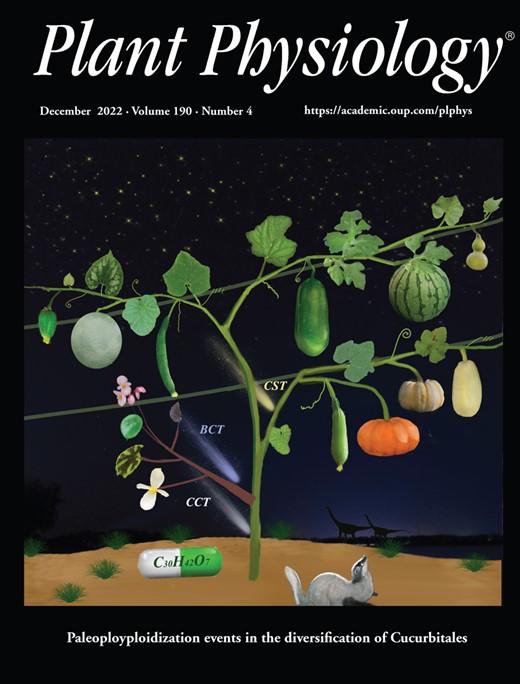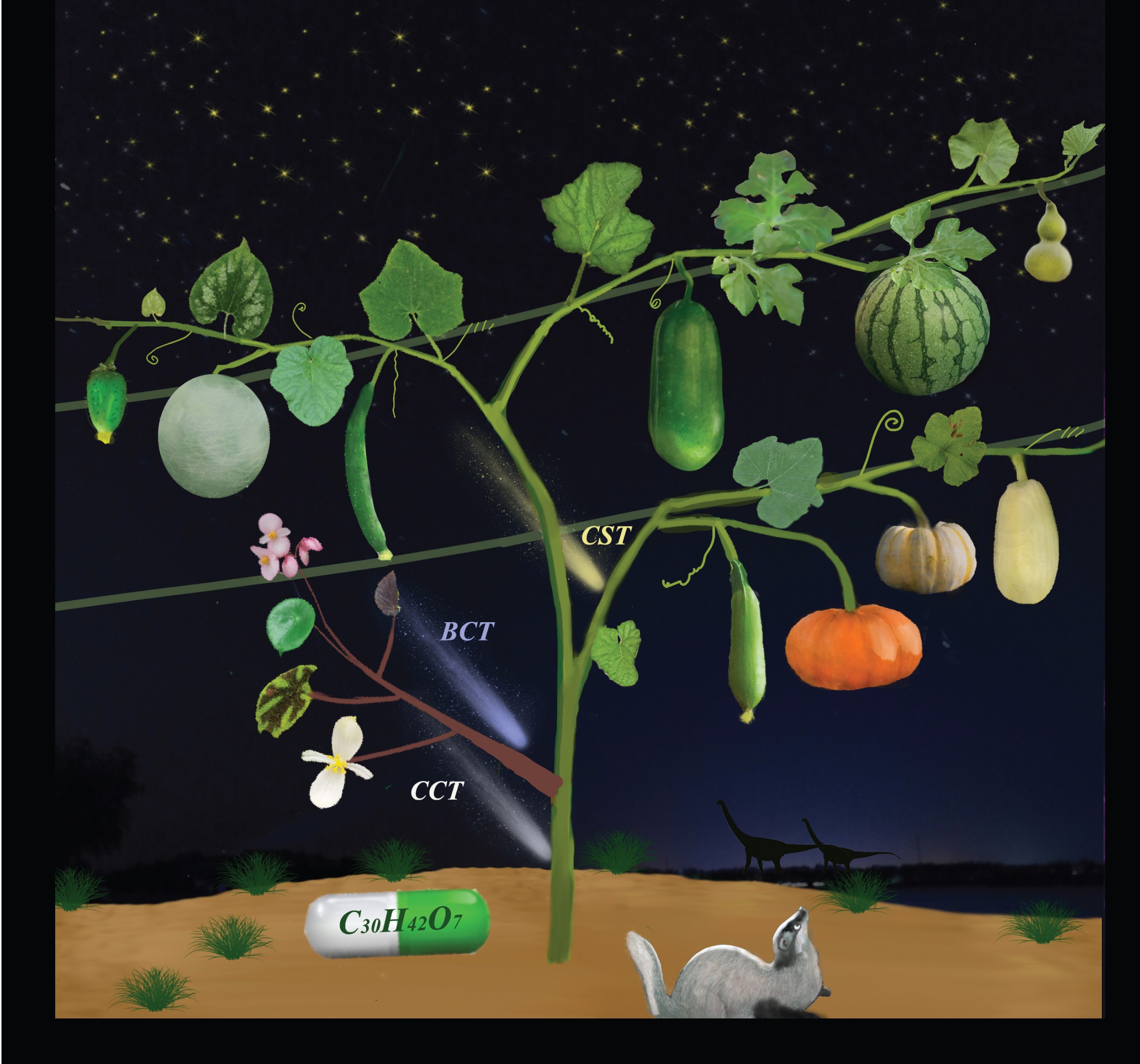
Cover image

Volume 190, Issue 4, December 2022
News and Views
Rhamnosyltransferases in Chrysanthemum: Just a spoonful of sugar helps the flavonoid-based medicines abound
STARTing to dissect the molecular determinants of GLABRA2 activity
At home and away: A mobile transcription factor regulates meristem development in discrete spatial domains
A common language: Cross-species network analysis reveals growth regulators
Watermelon goes viral: introducing a vector for virus-induced gene silencing in cucurbits
Take it easy in the heat: Transcription factors PIF4 and TCP4 interplay to slow leaf growth
Manganese management in plants: Golgi transporter determines manganese allocation and cell wall composition
Blown out of the water: mutation in calcium transporter CAX1 provides anoxia tolerance in Arabidopsis
A methylation that offers plants protection
A key piece emerges in the noncanonical gibberellin signaling puzzle: PLANT UBX DOMAIN-CONTAINING PROTEIN1
KUFfed by drought: A KARRIKIN-upregulated F-box protein compromises plant growth and survival under drought
A feast of consequences: Transcriptional and metabolic responses to lignin pathway perturbations
Letter to the Editor
Signaling and Response
Differential requirement of TIR enzymatic activities in TIR-type immune receptor SNC1-mediated immunity
Arabidopsis thaliana TIR-type immune receptor SNC1 (Suppressor of npr1-1, constitutive 1) requires NADase, but not the 2′,3′-cAMP/cGMP synthetase activity to trigger in planta immune responses.
Letter
Breakthrough Technologies, Tools and Resources
Wildsoydb DataHub: a platform for accessing soybean multiomic datasets across multiple reference genomes
The Wildsoydb DataHub is an integrated interface for biologists and breeders to access soybean genomic resources easily, allowing them to fully utilize the results of genomic research.
Update
Genes, Development and Evolution
Mendel: From genes to genome
The molecular nature of Mendel’s genes, the genetic resources available for pea, pea as a model for teaching and research, and recent controversies about Mendel’s data are discussed.
Research Report
Ecophysiology and Sustainability
Uncoupling differential water usage from drought resistance in a dwarf Arabidopsis mutant
Because some genotypes use water at different rates, an accurate comparison of drought phenotypes requires that all genotypes are exposed to uniform soil water content throughout drought treatment.
Research Articles
Biochemistry and Metabolism
Rhamnosyltransferases involved in the biosynthesis of flavone rutinosides in Chrysanthemum species
The discovery of rhamnosyltransferases in eight accessions of Chrysanthemum species contributes to the biosynthesis of flavone rutinosides and evolution of glycosyltransferases in plants.
Glucose-6-P/phosphate translocator2 mediates the phosphoglucose-isomerase1-independent response to microbial volatiles
The phosphoglucose isomerase1-independent response to microbial volatile compounds involves photosynthesis-related proteome resetting through long-distance glucose-6-P/phosphate translocator2 action.
Genome-edited rice deficient in two 4-COUMARATE:COENZYME A LIGASE genes displays diverse lignin alterations
Loss-of-function mutations of two 4-COUMARATE:COENZYME A LIGASE genes in rice result in distinctively different lignin compositional changes, demonstrating their diverse roles in lignin biosynthesis.
Arabidopsis plastid carbonic anhydrase βCA5 is important for normal plant growth
Plastid carbonic anhydrase activity supplies the required for anaplerotic pathways occurring in plastids and enables normal growth in Arabidopsis.
Breakthrough Technologies, Tools and Resources
Clay nanoparticles efficiently deliver small interfering RNA to intact plant leaf cells
Layered double hydroxide nanoparticles rapidly penetrate intact plant leaf cells and chloroplasts and efficiently deliver small interfering RNA to downregulate targeted genes.J. Y., B.C. R.Z., and Z.P.X. conceptualized and designed the research. J.Y. conducted experiments, data analysis, and wrote the first draft. M.W conducted experiments, data analysis, and conceptual visualization. S.B. and C.M. conducted the experiments. J.Y., R.Z., B.C., N.M., and Z.P.X. wrote and revised the manuscript. All authors read and commented on the manuscript.
Insights into the molecular mechanisms of CRISPR/Cas9-mediated gene targeting at multiple loci in Arabidopsis
The sequential transformation gene targeting method provides a broadly applicable technology for precise genome manipulation in Arabidopsis.
Cell Biology
An SNW/SKI-INTERACTING PROTEIN influences endoreduplication and cell growth in Arabidopsis
SNW/SKI-INTERACTING PROTEIN interacts with UBIQUITIN-SPECIFIC PROTEASE14 and ULTRAVIOLET-B INSENSITIVE4 to influence endoreduplication and cell growth in Arabidopsis.
POLLEN WALL ABORTION 1 is essential for pollen wall development in rice
The integrity of the pollen wall structure is essential for pollen development and maturity in rice.
Ecophysiology and Sustainability
Divergent leaf and fine root “pressure–volume relationships” across habitats with varying water availability
Mangrove species favor succulence in leaves and fine roots, with an accentuated hydraulic segmentation in the roots, whereas most karst species promote sclerophylly and belowground segmentation.
Modeling root loss reveals impacts on nutrient uptake and crop development
Root loss has a major impact on crop development and nutrient uptake; modeling reveals that the magnitude of the effect depends on species, root phenotype, and soil conditions.
Stomatal conductance tracks soil-to-leaf hydraulic conductance in faba bean and maize during soil drying
The hydraulic conductance between soil and leaf decreases exponentially with decreasing soil water potential, at a species-specific rate related to the decline rate of stomatal conductance.
Transcriptomic and metabolic signatures of diatom plasticity to light fluctuations
Diatoms use a series of complex and different responsive schemes in photosynthesis and carbon metabolism to optimize their growth under mild and severe light fluctuations.
Genes, Development and Evolution
The START domain mediates Arabidopsis GLABRA2 dimerization and turnover independently of homeodomain DNA binding
In GLABRA2 (GL2), the homeodomain is required for DNA binding, while the steroidogenic acute regulatory-related lipid transfer (START) domain plays a critical role in homodimerization and protein turnover.
Cell- and noncell-autonomous AUXIN RESPONSE FACTOR3 controls meristem proliferation and phyllotactic patterns
AUXIN RESPONSE FACTOR3 represses cytokinin activity and WUSCHEL expression to coordinate meristem activity noncell-autonomously, while it regulates phyllotactic patterning cell-autonomously.
Identification of growth regulators using cross-species network analysis in plants
Cross-species network analysis enables identification and validation of growth regulators in Arabidopsis.
Virus-induced gene silencing for in planta validation of gene function in cucurbits
A vector based on cucumber fruit mottle mosaic virus from Cucumis melo facilitates large-scale validation of male sterility-related gene functions in watermelon (Citrullus lanatus).
High temperature restricts cell division and leaf size by coordination of PIF4 and TCP4 transcription factors
High ambient temperature suppresses Arabidopsis leaf size by reducing cell proliferation via coordination of two diverse transcription factors integrating environmental and developmental signals.
Cellular and gene expression patterns associated with root bifurcation in Selaginella
The root of the spike moss Selaginella moellendorffii bifurcates following a cell division of the single stem cell, and the bifurcation involves conserved genetic modules known from angiosperm roots.
Mutation of histone H3 serine 28 to alanine influences H3K27me3-mediated gene silencing in Arabidopsis thaliana
A common whole-genome paleotetraploidization in Cucurbitales
The previously identified Cucurbitaceae common paleotetraploidization is shared by Cucurbitales and Begoniaceae.
Root acid phosphatases and rhizobacteria synergistically enhance white lupin and rice phosphorus acquisition
Phosphorus-responsive PURPLE ACID PHOSPHATASE12 and auxin-producing Bacillus spp. promote rhizosheath formation in Lupinus albus under soil drying conditions, enhancing phosphorus acquisition.
Gene expression and genetic divergence in oak species highlight adaptive genes to soil water constraints
Combining RNA-seq and a genome scan of genetic divergence between species highlights potentially adaptive genes in European white oaks.
DWARF AND ROBUST PLANT regulates plant height via modulating gibberellin biosynthesis in chrysanthemum
A distinct FlL/YAB3 subclade gene DWARF AND ROBUST PLANT regulates plant height by binding to the CmGA3ox1 promoter modulating gibberellin biosynthesis in chrysanthemum.
Abscisic acid-responsive transcription factors PavDof2/6/15 mediate fruit softening in sweet cherry
Transcriptome analysis identified a set of transcription factors essential for abscisic acid-promoted fruit softening in sweet cherry.
Acetylome reprograming participates in the establishment of fruit metabolism during polyploidization in citrus
Acetylome reprogramming plays an important role in trait evolution during polyploidization through regulation of enzyme activity and protein abundance.
Evolutionary analysis of the LORELEI gene family in plants reveals regulatory subfunctionalization
Expression divergence plays an important role in retention of Lorelei-Like GPI-anchored protein duplicates in angiosperms.
Spatiotemporal dynamics of the tomato fruit transcriptome under prolonged water stress
An extensive and tissue-specific transcriptional reprograming affecting metabolic, hormonal, and epigenetic pathways underlies tomato fruit development during drought acclimation.
Membranes, Transport and Bioenergetics
The trans-Golgi-localized protein BICAT3 regulates manganese allocation and matrix polysaccharide biosynthesis
Activity of BIVALENT CATION TRANSPORTER 3 in the trans-Golgi is critical for glycosylation reactions, plant growth under Mn deficiency, pollen tube elongation, and intracellular distribution of Mn.
Tonoplast-localized transporter ZmNRAMP2 confers root-to-shoot translocation of manganese in maize
A tonoplast-localized transporter enables root-to-shoot manganese translocation via mediating vacuolar manganese release of root stellar cells and contributes to low manganese tolerance in maize.
Signaling and Response
The vacuolar H+/Ca transporter CAX1 participates in submergence and anoxia stress responses
Plants lacking a vacuolar H+/Ca transporter are more tolerant to anoxia and submergence.
AtPRMT5-mediated AtLCD methylation improves Cd2+ tolerance via increased H2S production in Arabidopsis
Protein arginine methyltransferase 5-mediated methylation of l-cysteine desulfhydrase at Arg-83 increases its desulfhydrase activity and elevates H2S production in Arabidopsis.
GA signaling expands: The plant UBX domain-containing protein 1 is a binding partner for the GA receptor
The plant protein PUX1 interacts with the gibberellin hormone receptor and functions as a negative regulator of gibberellin hormone responses, including seed germination, plant growth, and flowering.
KARRIKIN UPREGULATED F-BOX 1 negatively regulates drought tolerance in Arabidopsis
A smoke-activated F-box protein negatively regulates drought tolerance by inhibiting stomatal closure, cuticle formation, and root hair development in Arabidopsis.
PtoWRKY40 interacts with PtoPHR1-LIKE3 while regulating the phosphate starvation response in poplar
A phosphate starvation response mechanism mediated by PtoWRKY40 and PtoPHL3 regulates the inorganic phosphate content in poplars.
PHYTOCHROME-INTERACTING FACTOR 4/HEMERA-mediated thermosensory growth requires the Mediator subunit MED14
The Mediator subunit MED14 promotes thermomorphogenesis by interacting with PHYTOCHROME-INTERACTING FACTOR 4 and HEMERA to induce the expression of growth-promoting genes at elevated temperatures.
INOSITOL (1,3,4) TRIPHOSPHATE 5/6 KINASE1-dependent inositol polyphosphates regulate auxin responses in Arabidopsis
Arabidopsis INOSITOL (1,3,4) TRIPHOSPHATE 5/6 KINASE1-dependent inositol polyphosphates bind to the auxin receptor complex and regulate auxin responses.
Early defoliation induces auxin redistribution, promoting paradormancy release in pear buds
Early defoliation promotes auxin efflux from buds to release paradormancy in autumn, inducing out-of-season flowering, which differs from release of apical-dominance-related lateral bud paradormancy.
Transcription factor WRKY28 curbs WRKY33-mediated resistance to Sclerotinia sclerotiorum in Brassica napus
BnaA03.WRKY28 interacts with BnaA09.VQ12 and takes precedence over phosphorylated BnWRKY33 to bind to the BnWRKY33 promoter, thereby weakening Sclerotinia resistance but promoting branching.
Ethylene response factor ERF.D7 activates auxin response factor 2 paralogs to regulate tomato fruit ripening
An ethylene response factor regulates tomato fruit ripening by activating auxin response factors involved in ripening.
The chromatin accessibility landscape of pistils and anthers in rice
Chromatin accessibility, histone modification, and transcriptome data provide valuable resource for rice floral tissue development.
CycC1;1 negatively modulates ABA signaling by interacting with and inhibiting ABI5 during seed germination
The C-type cyclin protein CycC1;1 interacts with ABSCISIC ACID INSENSITIVE5 (ABI5) to downregulate the expression of ABA-responsive genes and ABI5 itself, thereby inhibiting ABA signaling during seed germination.
Systems and Synthetic Biology
Transcript and metabolite network perturbations in lignin biosynthetic mutants of Arabidopsis
Analysis of transcripts and metabolites in wild-type and 13 lignin biosynthetic mutants of Arabidopsis reveals the global impact on transcription and metabolite network perturbations.
Knockout of MITOGEN-ACTIVATED PROTEIN KINASE 3 causes barley root resistance against Fusarium graminearum
TALEN-based knockout lines of HvMPK3, showing elevated antioxidant capacity mitigating ROS production and root cell wall stiffening by suberin, confer barley root resistance to Fusarium graminearum.















































